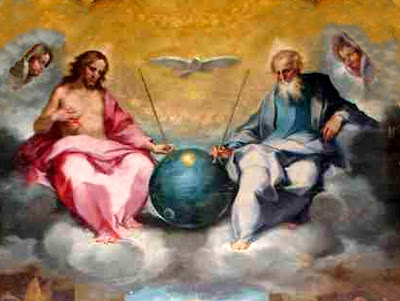Glorification of the Eucharist by Ventura Salimbeni, Ventura di Archangelo Salimbeni also later called Bevilacqua January 20, 1568 – 1613
Ventura Salimbeni, the son of Arcangiolo Salimbeni, passes for the third best scholar of that master; though, in truth, he could have received but few lessons from his father. Ventura quitted home at a very early age, and, wandering through the different cities of Lombardy, studied the works of Coreggio and other Lombard masters, whose style was then growing into repute in Tuscany. He next repaired to Rome, and contrived to raise great expectations of his future eminence, which, having afterwards given himself up to pleasure, he never realized.
He left behind him various frescos of these, the Abraham entertaining the Angels, in one of the chapels of the Jesuit church, best bespeaks the consummate master. We there discern a sprightliness and gracefulness in the colouring and countenances, which he ever afterwards retained: we discern, too, a carefulness of design and chiaroscuro, which he afterwards but too frequently neglected. Ventura sometimes wrought in company with Vanni; and, though the latter was eight years younger than himself, not improbably derived benefit from him.
Certain it is, that in many of his works he resembles him in his imitation of Barocci's style; while he scarcely yields to him in gracefulness of contour, expression, or soft and lucid colouring. Ventura's performances in S. Quirico and S. Domemco are much admired: in the former is the Angel appearing at the Sepulchre of Christ; in the latter, a Crucifixion, with various Saints, which surpasses most of his other works; though there are some of great merit in ther places at Siena; especially where he was stimulated by the proximity of the more distinguished masters of his native school.
Glorification of the Eucharist by Ventura Salimbeni in the church of St. Peter in Montalcino (Siena, Italy), painted Circa 1600 by Ventura (also later called Bevilacqua) Salimbeni. The sphere between the figures of the Holy Trinity is painted in many Trinity representations, is a symbol of the "Creation Globe", and in this particular painting contains the illustration of the Sun and the Moon.
This IMAGE (or other media file) is in the public domain because its copyright has expired.This applies to the United States, where Works published prior to 1978 were copyright protected for a maximum of 75 years. See Circular 1 "COPYRIGHT BASICS" PDF from the U.S. Copyright Office. Works published before 1923 (in this case Circa 1600) are now in the public domain.
This file is also in the public domain in countries that figure copyright from the date of death of the artist (post mortem auctoris) in this case Ventura Salimbeni (1568 – 1613), and that most commonly runs for a period of 50 to 70 years from December 31st of that year.
TEXT CREDIT: Lanzi's luminaries of painting By G.W.D Evans














No comments:
Post a Comment